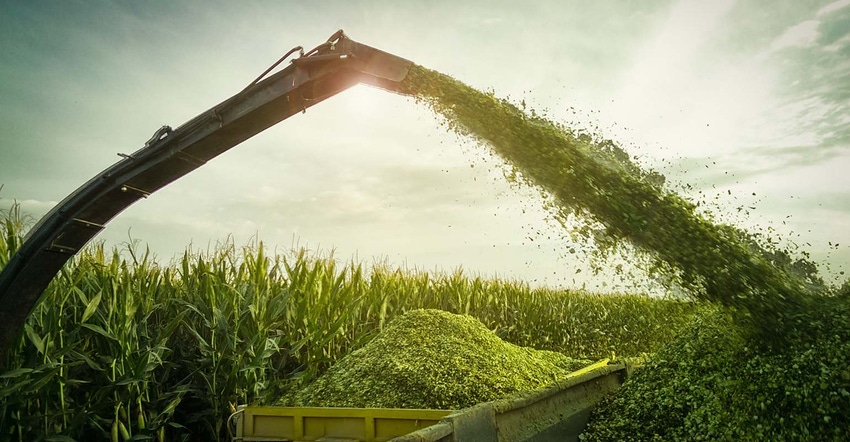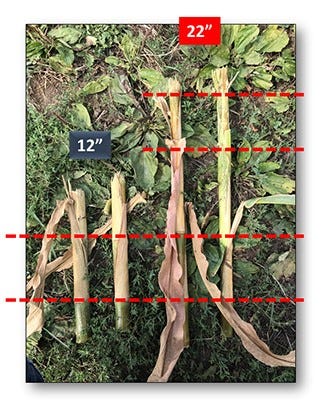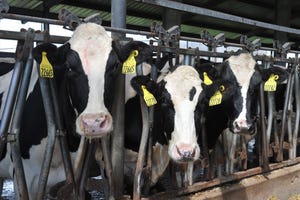Benefit of higher harvest cut heights for brown midrib corn silage
Investigation suggests harvest cut height can improve nutrient composition and forage quality.
June 13, 2023

The dairy industry is always striving to improve animal feed in order to maximize nutrition, animal health and milk production. High-quality forage is the basis of any healthy cow's diet, and whole-plant corn silage is the most common version eaten by dairy cows worldwide. A recent study published in Applied Animal Science evaluated the effects of cut height and inoculant application on brown midrib whole-plant corn silage quality. The study—conducted by a team of researchers at the University of Illinois—found that increasing the cut height at harvest can improve silage nutritional value, potentially reducing the amount of ground corn needed for rations and saving on feed costs.
Lead investigator Felipe C. Cardoso, PhD, of the department of animal sciences at the University of Illinois Urbana, explained that "milk production systems present several challenges for dairy farmers and nutritionists, so we're working to study tools that can lighten the load by improving animal feed and milk production."
Their work focused on brown midrib corn, which has long been documented for having superior feed value and especially for improving the fiber digestibility for cows, making it best for high-producing dairy animals.
The research team evaluated both the effects of cut height on the corn silage and the application of inoculants, which can speed up fermentation and prevent undesirable microbes and spoilage. The study used two cut heights, a low-cut height of 30.5 cm and a high-cut height of 56 cm, and three commercially available inoculants, namely Lactobacillus plantarum and Pediococcus pentosaceus, Propionibacteria freudenreichii and Pediococcus pentosaceus, and Lactobacillus buchneri and Pediococcus pentosaceus. Samples were harvested and stored in mini silos, which were opened at 5 fermentation time points: 0 days, 2 days, 5 days, 30 days, and 90 days.

The results of the study showed that, although the high-cut height produced a lower overall harvest amount, it increased nutrition value through higher concentrations of dry matter, crude protein, and starch, while boosting fiber digestibility and predicted milk output.
"Our findings suggest that producers should consider the trade-off between yield and quality when deciding on a cut height for their crop. This higher nutritive value of the high-cut corn silage could potentially allow for an increased quantity of forage in a dairy cow's total mixed rations and decrease the amount of ground corn needed, providing an important cost savings to the dairy producer," explained Cardoso.
However, the fermentative profile of the high-cut silage was reduced compared to the low-cut height, and applying the inoculants failed to improve the fermentation profile for either cut height. "The team's results indicate that in the present conditions, the use of inoculants did not improve the corn silage's fermentation profile," said Cardoso, "suggesting that the fermentative profile of brown midrib corn silage may be more dependent on the initial crop quality than on inoculant type."
Overall, the study provides valuable insights into the effects of cut height and inoculant application on silage quality, which can help dairy cow producers, nutritionists, and veterinarians make more informed decisions about their animals' feed. David Beede, PhD, editor in chief of Applied Animal Science, emphasized the importance of these findings.
"Providing sufficient dietary energy and nutrients for high-producing dairy cows is a challenge. This investigation examines optimum harvest cut height of whole plant brown midrib corn for silage and use of three commercially available microbial inoculants that might optimize fermentation during ensiling to maximize forage quality,” said Dr. Beede. “Results suggest that optimizing and managing harvest cut height can affect nutrient composition and forage quality--while microbial inoculants showed no effects on fermentation profile."
You May Also Like



